The Whistling Thorn
dancing bears & fairy lanterns
Three Deer Heath, Norfolk, 12 January 2025
Hello, and welcome to this mid January, just-after-full-moon edition of Bracken & Wrack, brought to you from a Norfolk flint cottage between the heath and the sea.
By the way, through a chance conversation this morning I’ve realised that it may not be obvious that the ‘bracken’ is for the heath and the ‘wrack’ for the sea, so I thought it might be a good time to clarify that for those whose minds aren’t as strange as mine :-)
After the iciest (is that a word?) weekend for ages, we’re now in thaw and the lane is a sea of mud. That’s probably preferable to the sheet of ice that completely enveloped the tarmac for a couple of days, liberal in its deception until you tried to walk down to the heath and remain upright. But the stunningly beautiful light made up for it. As we walked through a frosty Dancing Bear Wood on Sunday, the January sun rayed out its rods of palest gold before us, catching and playing over the bronzed bracken. Sparkling droplets hung from the ends of birch twigs; tiny crystal balls revealing a magical world of woodland sprites and shadows.
And now as I sit here contemplating how early it would be acceptable to light the wood stove, I’ve had another thought. Sometimes, as I put together the stories for Bracken & Wrack a clear theme seems to emerge all by itself. This time, rather than an overall theme I can see how one stepping stone might lead to another. I shall try to place these carefully so that the jump from stone to stone and bank to bank tells a story of the bright new year that I really hope you’ll enjoy reading.
So make sure your flask is filled with a warming brew, pop this spiced gingerbread muffin wrapped in crackling brown paper into your backpack and let’s set off together.
In this edition:
Neither Sand Nor Stone: the beautiful desolation of Shell Bank
A 1930s Fenland Childhood: wild skating
Poetry by John Clare
Finding the Fair: how Dancing Bear Wood got its name
Whittlesey Teaser and photos ;-)
Lamb’s Wool For The Straw Bear: a wassail bowl
You may remember that in the last Bracken & Wrack newsletter, The Turning Stars, I included a poem inspired by a New Year’s Eve visit to the chapel of St Peter-on-the-Wall at Bradwell in Essex. I thought it might be good to begin this edition where the trail we were following left off.
So, let me tell you what happened on stepping out from the chapel’s thick flint walls and making for the salt-scorched hedgerow fringing the sea wall just behind it:
Shell Bank, Bradwell-on-Sea, Essex, 31 December 2024
Such a strange structure nestled under the sea wall. Its rickety silhouette somehow completes the skyline: a gawky skeleton holding hands with the tall sturdy chapel that's as surely rooted in the land as the tower's criss-cross scaffolding rests on air. Well, on shells actually. The map on the information board labels this area as ‘Shell Bank’ and when you step down from the sea wall with a crunch you soon understand why. Even viewed from above you can see there’s something strange going on, with pale drifts of a substance neither sand nor stone showing ghostly under the iron clouds.
Shells thrown up against a tangle of sea bushes. I don’t know what they are, but a sea-witch should learn. It takes time, tide and gazing into the cracks in the mud to start to gain an inkling.
I’ve never seen mud flats so vast, so infinite. If you squint you can make out a narrow strip of river - or is it the sea? - but only just. Easier to see are the sparkly lights, tiny fairy lanterns twinkling through the mist. Twilight comes early on a grey New Year’s Eve. The sky isn’t completely leaden though. Its sweep is complex and the muddle of greys beguiling.
The shell bank - left to right on the horizon you can see the chapel, the wooden tower and the huddle of trees sheltering the Othona community. 31 December 2024
The slippery seaweed under my boots is an indescribable shade of brown-green as are many of the rocks and shells, touched by mud and weather. The shapes of the clams - I think they’re clams not oysters - are fantastical. Twisted into layers, flounces, waves. Crazy piecrust, a fairground ride. Some of them join in two halves, and even those don’t mirror each other but go off on their own wild journeys.
Egrets beat slow wings over the marsh. Startlingly white, they’re no gulls. Flapping low I can just make out black beaks and legs. I wonder whether they call this mudflat home or whether they, like us, are just passing through and wondering at this uncanny landscape; its colours, scents and beautiful desolation.
A bell sounds from somewhere behind the trees that wrap the Othona community in their embrace. It’s just before 4pm and already dusk. I think it’s a call to prayer, to the simple service held twice a day within the strong, thick arms of St Peter-on-the-Wall. How can a building sitting over the gatehouse of a Roman military fort feel so supremely peaceful and spiritual? Thick with spirit, secure in its spot as it has been since 654 or thereabouts.
The story goes that St Peter once came here and sat on the fort’s wall, but it’s enough for me that the chapel was built on its foundations. One layer upon another, while the rest of the mighty stronghold with its towers and 20-foot-high walls quietly disintegrated. Or perhaps its end wasn’t quite so gentle. Stone, tile and other Roman materials would surely have caught the eye of people who could use their enduring qualities. Certainly there are flurries of thin red Roman tile high in the rough chapel walls.
Had it really been a good idea to go so far afield with high winds and heavy rain expected? But still we had been drawn to this poignant place where land, sea and sky meet. Where there is so much of nothing that is somehow so much of something.
You scoop up a handful of bleached shells with their thin rattle, let them flow between your hands into a ring, performing your will. Quickly I follow suit until the two halves of the circle meet. You work backwards and forwards with focussed intent, heaping, mounding, laying a sprig of seaweed here, a strand of twiggy vegetation there. I place a couple of larger treasures. An orange whelk, a greenish clam all wavy-edged. Earth, air and water run delicate fingers over each other.
It’s done. The light is fading fast but the mound shimmers with its own presence. Marking the place, the time, the end of a year now spent and the liminal edge before a new one rings out its shining bells.
And now the first firework turns a somersault in the sky. We gaze at the wheel as it explodes in the dark, a mandala of sorts, marking the heavens with fire.
Frosty footpath into Dancing Bear Wood: ‘the old heath’, 12 January 2025
I love to see the old heath's withered brake
Mingle its crimpled leaves with furze and ling,
While the old heron from the lonely lake
Starts slow and flaps its melancholy wing,
An oddling crow in idle motion swing
On the half-rotten ash-tree's topmost twig,
Beside whose trunk the gypsy makes his bed.
Up flies the bouncing woodcock from the brig
Where a black quagmire quakes beneath the tread;
The fieldfares chatter in the whistling thorn
And for the haw round fields and closen rove,
And coy bumbarrels, twenty in a drove,
Flit down the hedgerows in the frozen plain
And hang on little twigs and start again.
John Clare, ‘Emmansail’s Heath in Winter’
*just in case you didn’t know, bumbarrels are long tailed tits :-)
A 1930s FENLAND CHILDHOOD: wild skating
The alder carr last Sunday: a fairytale winter wonderland, 12 January 2025
In an occasional series, I’ve been drawing on my mum’s memoir Poultry, Plums and Fen Runners. Sylvia Ashmore was born in Chatteris in 1927 but she, her brother and parents soon moved over the border to Earith in Huntingdonshire. Most of her extended family lived within a small radius in that part of the Fens - including cousins at Hemingford Grey where my favourite Green Knowe books are set :-)
Mum was determined to finish her book before she died aged 95 and she she did achieve this, my brother doing the layout for her and making a few copies for family members. The Fens were, and indeed still are, a world apart and it’s fortunate from a Bracken & Wrack point of view that we have this first hand account to draw on before the oldest ways are lost forever or have to be guessed at.
Having tiptoed to the edge of the alder carr last Sunday, enchanted by its transformation to fairy ice palace, it feels like the perfect time to talk about skating in the Fens.
When Sylvia was a child, fenland winters tended to be much colder and longer than they are now, and waterlogged dykes and fields remained frozen for what seemed like weeks. Once word got around that the ice was ‘bearing’, Mum and Uncle Tom - who had passed the Scholarship and therefore attended Huntingdon Grammar School - rushed home from school by bus, train and bike as quickly as possible, hoping that their friends who were still at the village school would have called at their home to collect their skates for them. The low lying land between the river and the road at Bury Fen between Earith and Bluntisham usually flooded in the winter and provided a huge ice rink when it froze. All the friends would meet up there and skate until it was time to go home for tea.
The skates they wore were called fen runners, referenced in the title of Sylvia’s book. They consisted of a blade affixed to a shaped wooden sole which was screwed onto the sole of a boot, with straps holding the skate in place over the foot. The blade was quite broad with a graceful upward curve at the toe end.
In my mum’s garage I found a set of skates exactly matching this description. I don’t know for sure that they were actually hers but it seems very likely. The idea of that great big screw through the bottom of your boot is a bit scary but you do get the idea of how they fitted. The straps are lost but they are definitely beautiful objects in their own right.
The ‘fen runner’ skates I found in my mum’s garage.
If Bury Fen was busy after school it was positively crowded at weekends, with many people skating and others watching. Learners would move tentatively, often pushing a chair ahead of them for support. Sometimes the ice cracked noisily, but as far as that went there was a useful piece of fen-lore that ran:
She cracks, she bears;
She bends, she breaks.
(I really like the thought of personifying the ice as ‘she’.)
‘Sometimes, adults would skate in pairs, crossing hands and striking out together. Really proficient speed skaters raced each other, leaning forward and swinging their arms with each stroke. When racing, they leaned forwards and crossed their arms behind their backs for less wind resistance. There might be a line of men, one behind the other, each having a hold on the one in front of him.’
But the cold winters of the 1930s were apparently nothing compared to the winters when my grandfather, Holley Ashmore, was a boy. He told my mum of skating on the rivers themselves, and of hog roasts held on the ice. At the end of the nineteenth century and beginning of the twentieth (he was born in 1896) the frozen rivers were used as a means of getting from one place to another. Tales were told of skating to Houghton via St Ives and back to visit relations, and of skating to Ely and back, having dinner and then skating to St Ives in the afternoon. Mum had an Earith friend who had himself skated to St Ives on the river during the very hard winter of 1963.
Bury Fen was nationally known in the old days, when the regular flooding and freezing of the fen made it the best part of England for what we would now call ‘wild skating’ :-) The hundred acres of thickly frozen ice provided fun for thousands of people without overcrowding - can you even imagine?! According to Sylvia, skating on blades probably dates from the eighteenth century, introduced from Holland. But the fen folk may well have learned to skate earlier than this through the example of Flemish refugees or the Dutch men working on drainage of the Fens (hated as they were).
By the end of the eighteenth century, skating had been established as a competitive sport. In favourable winters, championship races were held at Bury Fen with money and cups as prizes. We know that William Ayres of Earith was a famous professional skater in the first half of the nineteenth century. Amateur races were started in 1880 and local skaters including Turkey Smart [what a great name!] and the Tebbutt brothers became well known Long distance challenges were put in place, covering 60 to 70 miles in a day and keeping to the rivers and dykes.
Bury Fen was also known as the birthplace of bandy, a forerunner of ice hockey derived from the local game of shinty or shinney. This had traditionally been played in any open space but when transferred to ice it became more formal, with goals and a marked out pitch about the size of a football pitch. The game was played with bent sticks usually cut from a pollarded willow or ash tree. The ‘cat’ or ball was made of fabric, the local tailor using cloth selvedges wound tightly and sewn into a ball about three inches in diameter. Wow, how frugal and what a great idea!
Inter-village games of bandy were played on Bury Fen in the late eighteenth century and continued throughout the nineteenth century.
It’s said that the Bluntisham and Earith joint team were unbeaten for over a hundred years.
But then again as we’ve already heard, local children started practising almost from the cradle, pushing a chair in front of them.
Detail of the patina of the wooden soles, decorated with stars. What stories of frost and fire they could tell.
After the beautiful desolation of the Essex mudflats, and acres and acres of fenland ice, both in East Anglia, it’s time to bring in the next stepping stone. We’re still in the flatlands, but this time we go to Whittlesey in Cambridgeshire, where even the wheelie bins proudly proclaim that we’re still firmly in the Fens.
And just to draw the stones closer together making it easier to hop across - do you remember the location of the very first photo in this newsletter? Yes, Dancing Bear Wood just down the lane from here. Now, it may or may not come as a surprise that I named that wood myself, inspired by wild imaginings of medieval Lady Day fairs on the Common with their colours, scents, sounds and yes, perhaps the sight of acrobats and dancing bears.
In fact, before I go any further I thought I would link in a very old YouTube video of mine from exactly this time of year - published 21 January 2021 - in which we wander through Dancing Bear Wood together and I do my best to paint the picture I have in my mind’s eye.
Walking again through Dancing Bear Wood the very day after returning from the Straw Bear Festival at Whittlesey, the coincidence suddenly struck me. Just hours beforehand, we had been watching spellbound as Straw Bears danced through the streets, accompanied by all the colour, sound and spectacle of dozens of Morris and Molly dancers and musicians. And although I had heard of the Straw Bear Festival as a unique folk custom, when I named the wood I had no idea that I would ever have the opportunity of witnessing it myself.
Being in the thick of the Whittlesea (as it’s also spelled) Straw Bear hurly-burly was an unforgettable and overwhelming experience, so I am going to save my write-up for the next edition of Bracken & Wrack. But meanwhile - and while the straw is still settling - here are a fewS photographs to offer a tiny taste of that brilliant January day. Hope to see you there next year :-)
Sutton Masque perform traditional Fenland dances, 11 January 2025
Tyler’s Men take their inspiration from Dick van Dyke’s character in the film Mary Poppins
Straw bears dancing with Chiltern Hundreds Clog Morris, 11 January 2025
LAMB’S WOOL: The Straw Bear’s Wassail Bowl
Like the rest of us, Straw Bears appreciate a warming drink when out on a cold January day. Considering that the procession once wound its way from pub to pub in the days when Whittlesey boasted an eye-watering 32 hostelries - now there are only 5 or 6 - it’s not surprising that a drop of the good stuff has always played a large part in proceedings.
On Saturday I noticed several people swinging their own pewter tankards by their sides rather than settling for pub glasses or, worse, plastic beakers. This traditional hot medieval brew, served around Twelfth Night or Epiphany would be perfect sipped from one of these, I imagine. It’s eminently suitable, too as a celebratory drink for Plough Monday and Straw Bear Tuesday (the festival is now held on the nearest Saturday), not to mention Old Twelfth Night/Epiphany on 18/19 January when many Wassail ceremonies take place these days.
There are many variations on the contents of the Wassail Bowl. This version is known as Lamb’s Wool for reasons you will understand when you see the recipe. Feel free to interpret it loosely as I’m sure our ancestors did. Oh, and don’t forget to reserve some of the brew to bless your apple or other fruit trees so they will be fruitful during the coming season.
6 Bramley apples (use Bramleys or you won’t get the fluff)
1.5 litres cider or real ale
150g brown sugar (I use coconut sugar)
Half a nutmeg, grated
Thumb-sized piece of ginger, peeled and finely chopped
Apple brandy, cognac or rum (optional)
Oven 190C. Core the apples and place in a baking dish, covered with foil or parchment, tucked around them. Bake for 30 - 45 minutes until very soft, then leave to cool.
In a pan, gently heat the ale or cider with nutmeg, ginger and sugar until the sugar dissolves. Scoop the apples from their skins into a bowl, mash with a fork and add to the pan.
Cook gently for 10 minutes more, then give a quick blitz with a hand-held blender (if available) to further integrate the apple. Serve in heat-proof glasses or mugs, topped with a warming dash of spirit if desired.
Here’s to thee, Old Apple Tree,
Whence thou may bud and whence thou may blow,
And whence thou may’st bear apples anow,
Hats full, caps full, bushel, bushel sacks full,
And my pockets full too. - Traditional
Full moon and rosy sky just before dusk, Bacton, Norfolk, 13 January 2022
Until next time.
With love, Imogen x

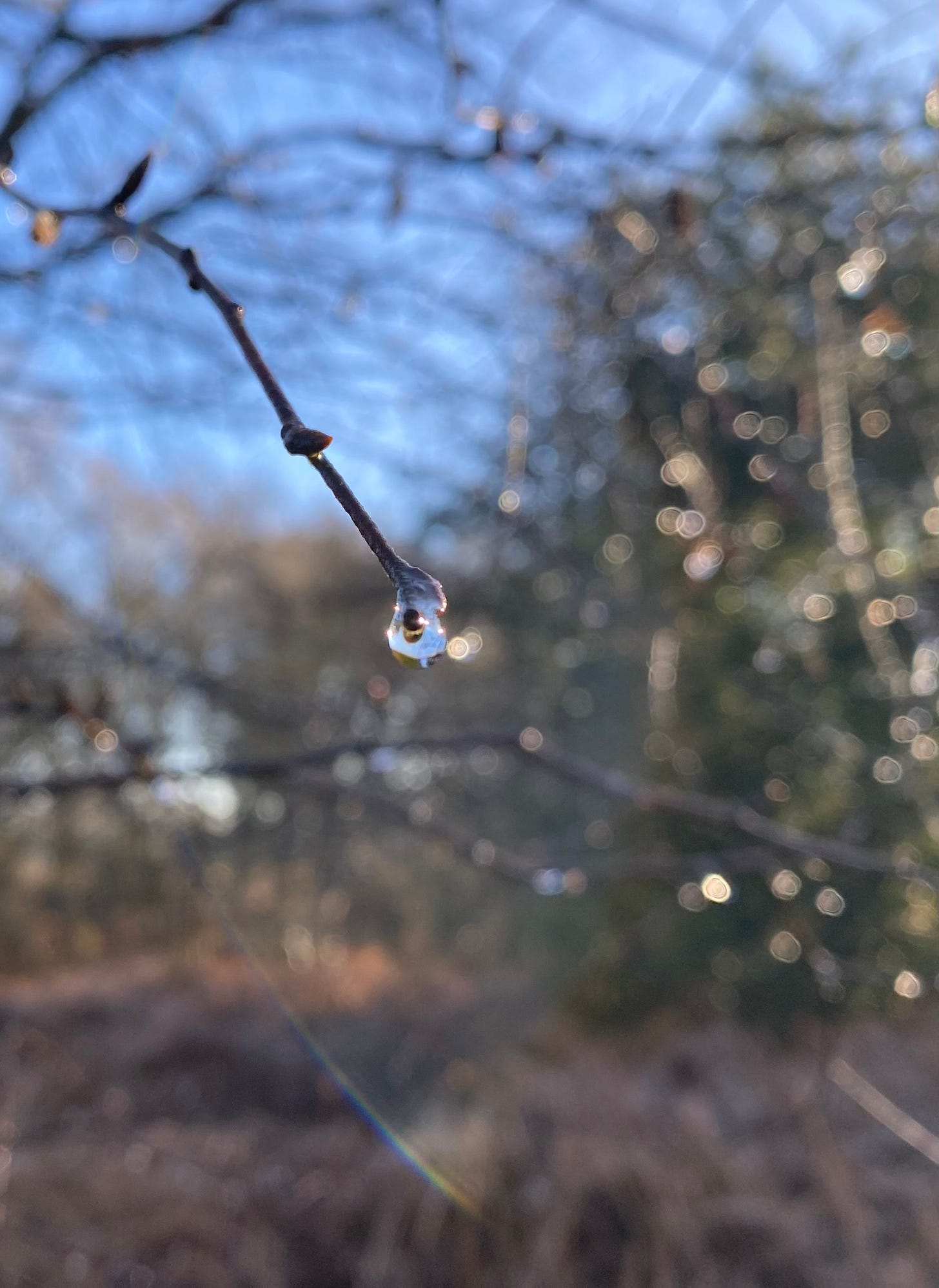
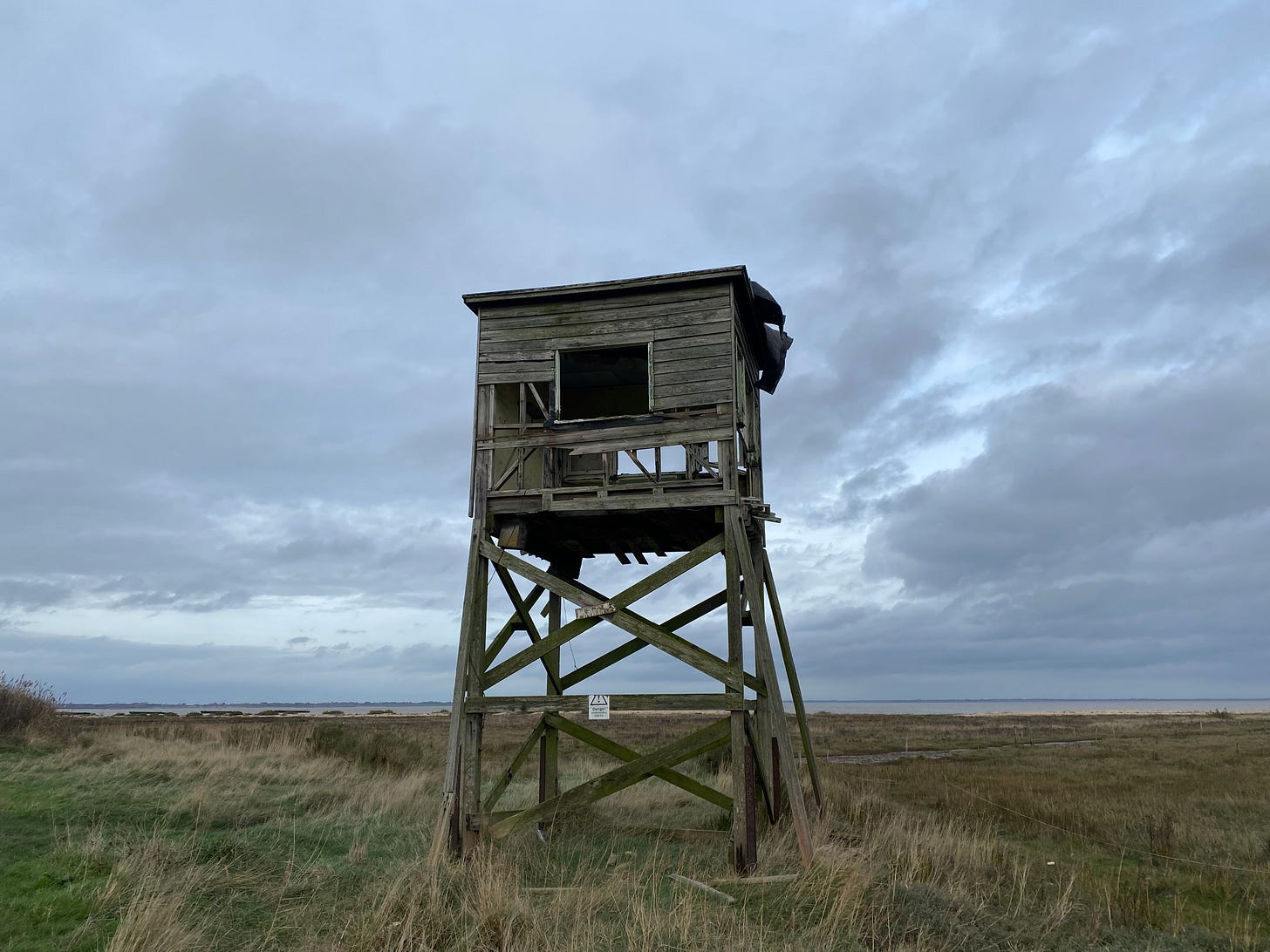
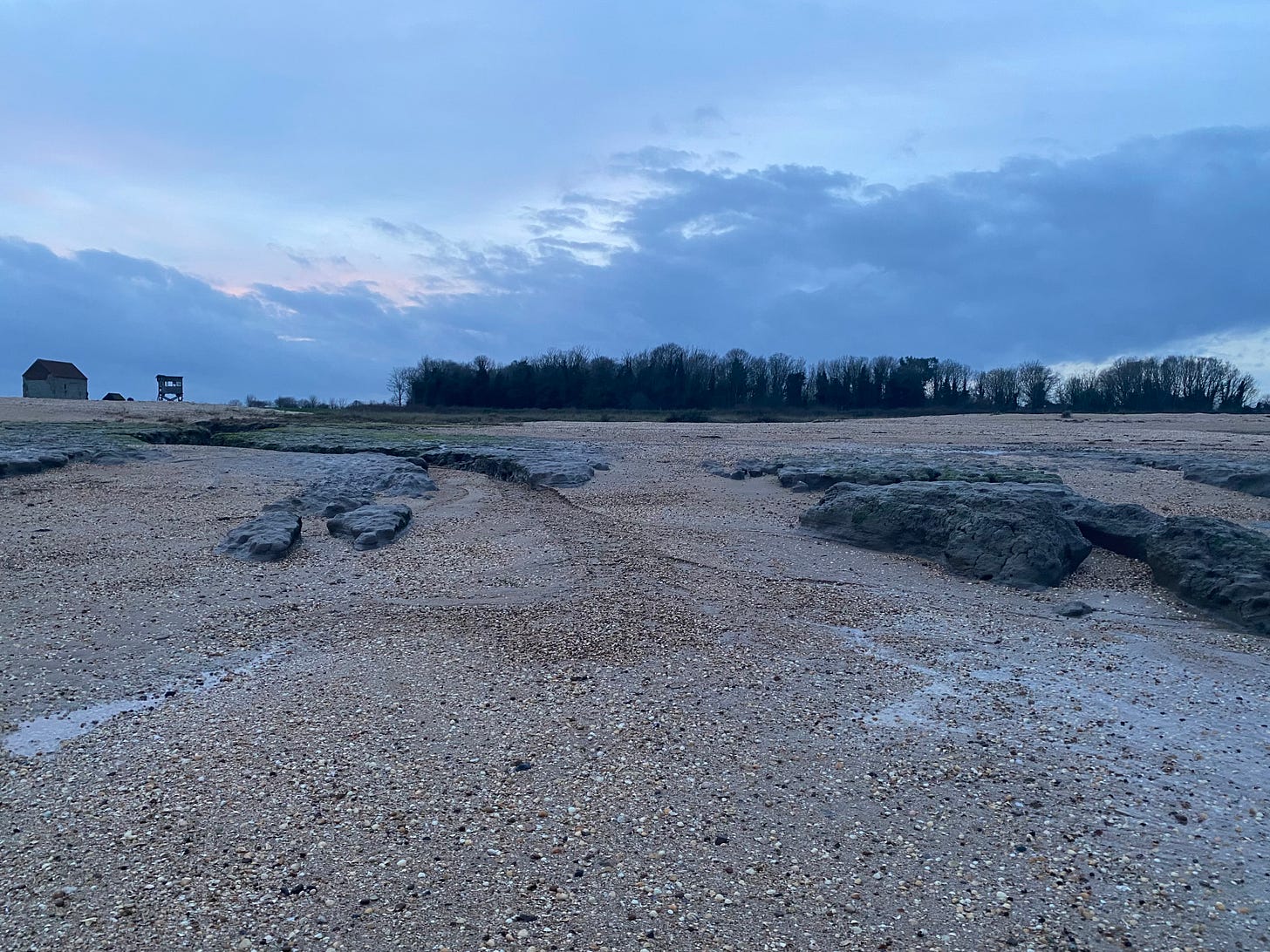




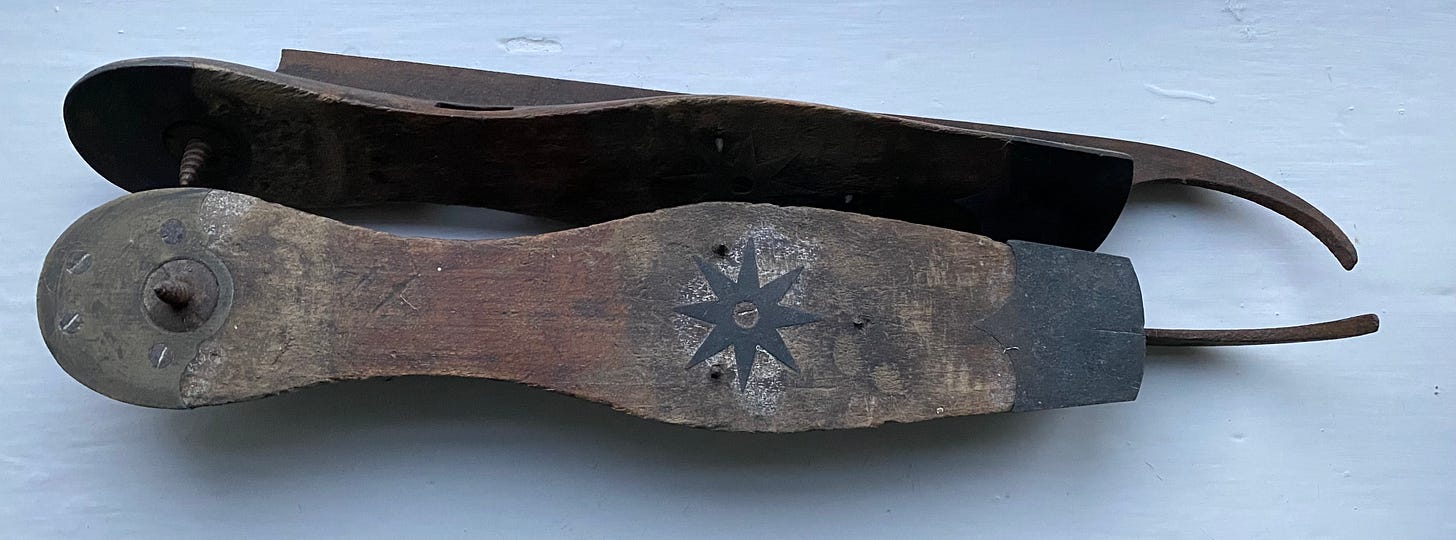

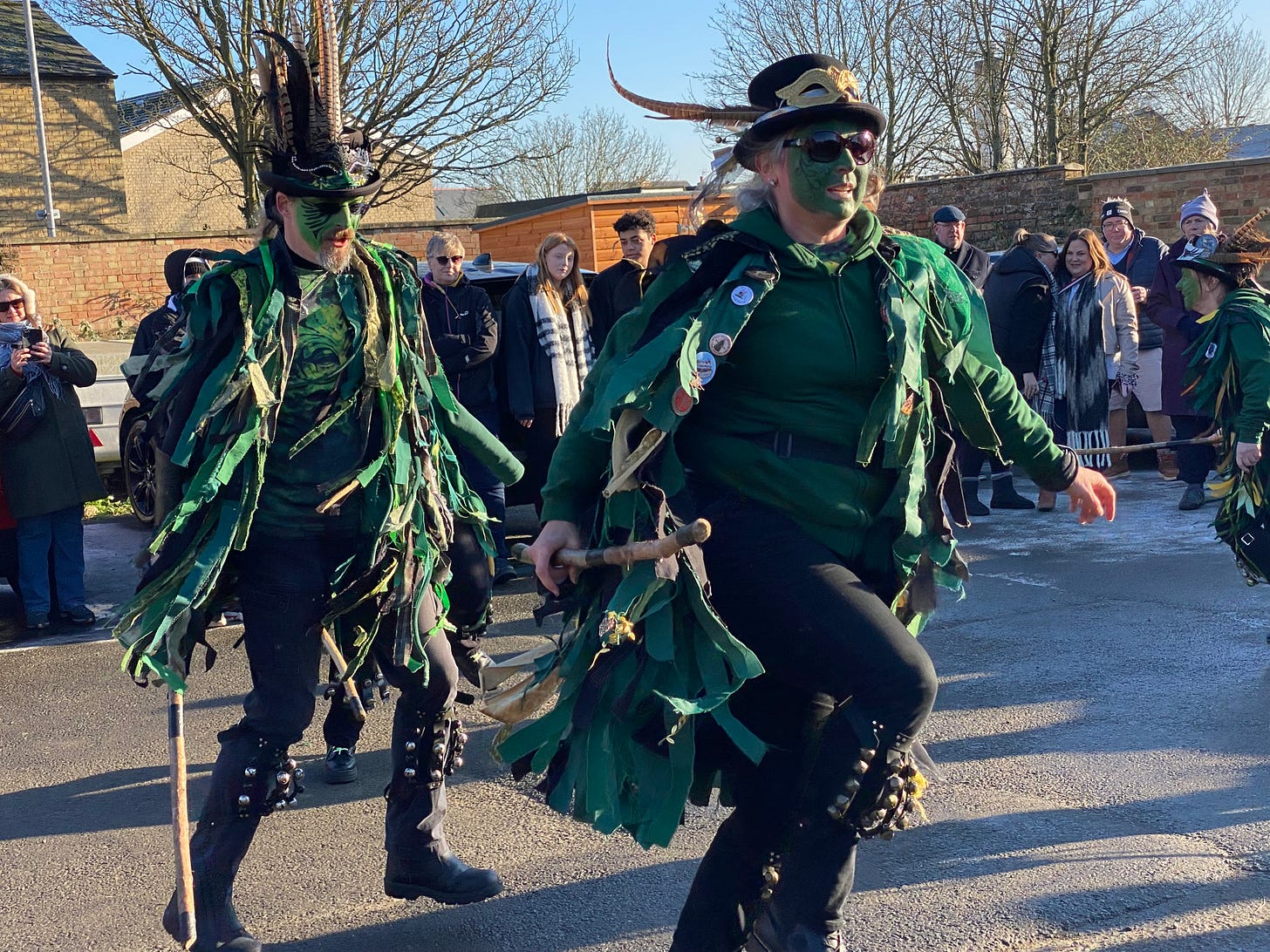
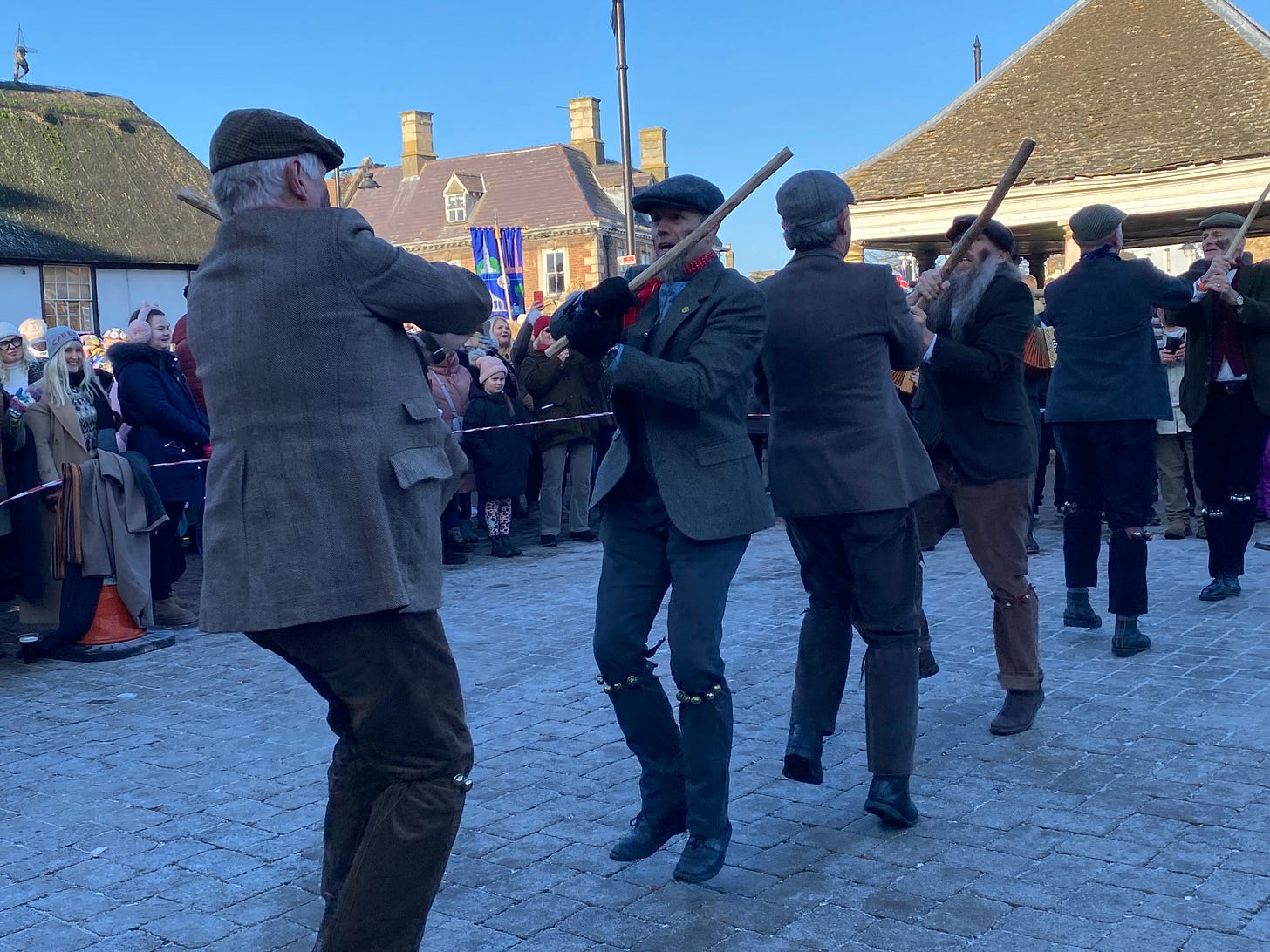

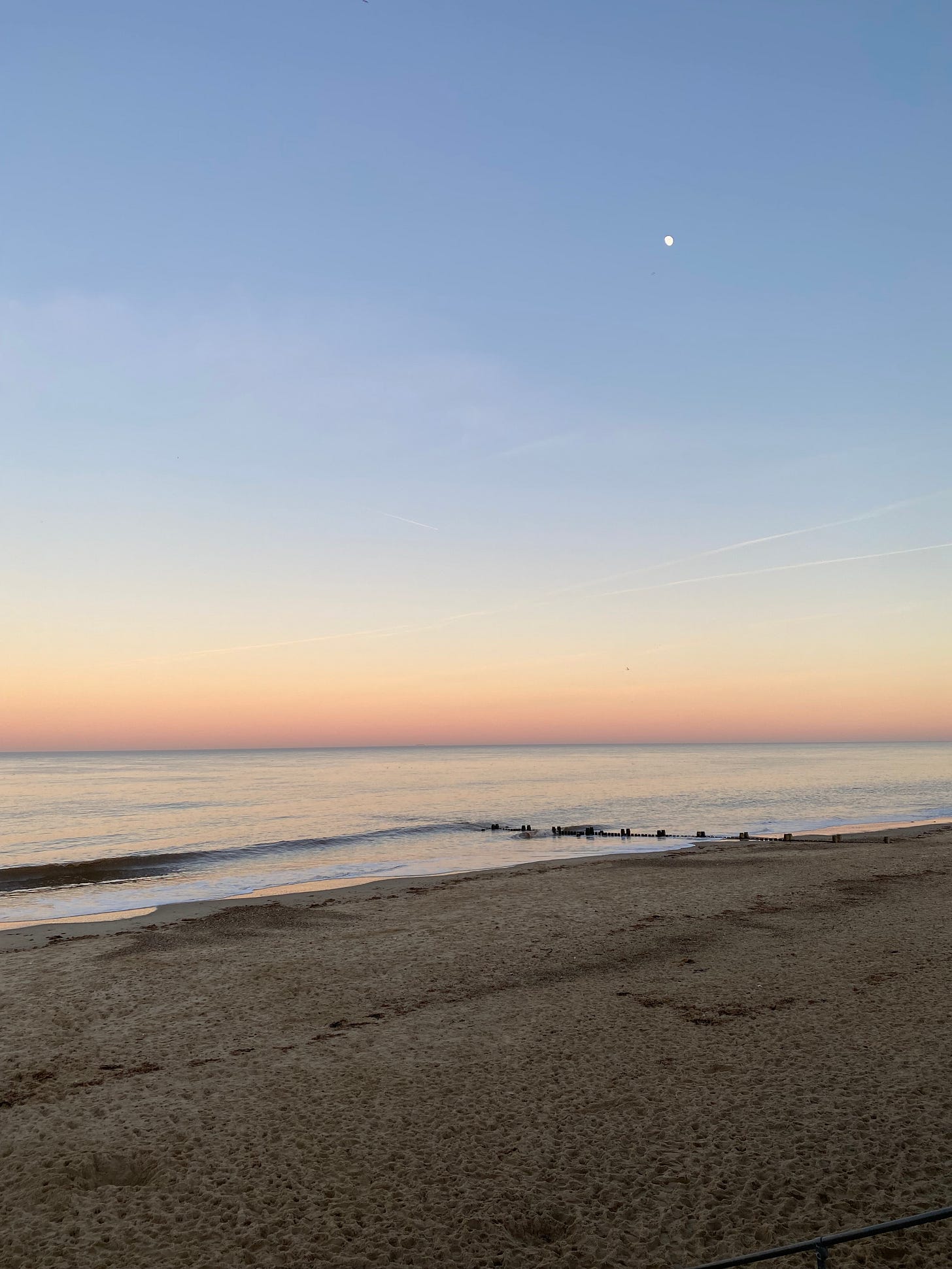
I picture in my mind’s eye your mum’s fen runners hanging on a wall in your cottage.
Canadian children still learn to skate at an early age by pushing a chair and shinny is still played by my husband, at an indoor rink mostly, also known as Pick- Up hockey, because it’s an informal game usually without goalies.